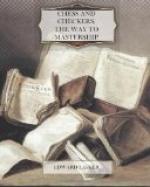Check and Checkmate
If a man makes a move which attacks the opposing King the King is said to be in “check.” The player whose King is checked then has to make a move which gets the King out of check
+---------------------------------------+ 8 | | | | | | | #K | | |---------------------------------------| 7 | | | | | | #P | #P | | |---------------------------------------| 6 | | | | #B | | #Kt| | #P | |---------------------------------------| 5 | | | | | | | | | |---------------------------------------| 4 | ^P | | | | | | | | |---------------------------------------| 3 | | | ^P | | | | | ^P | |---------------------------------------| 2 | | | | | | | ^P | | |---------------------------------------| 1 | | | | | ^R | | ^K | | +---------------------------------------+ a b c d e f g h
Diagram 5.
or he forfeits the game. This is the only case in which a player is not at liberty to make any move he likes.
Unless the attacking man can be captured there are only two ways of getting out of check. One of these is to interpose a man between the King and the attacking piece, and the other to move the King out of the line of attack. In Diagram 5 Black could give check by moving the Bishop to c5. In answer to this White has four moves at his disposal. He may either move the King to f1 or h1 or h2, or he may interpose his Rook on e3. The latter would be very unwise as Black would simply take the Rook with his Bishop, again checking White’s King. The situation would then not have changed at all except that White would have lost his Rook. White’s King could not move to f2, for this would leave him still attacked by the Bishop.
Instead of checking on c5 Black could have attacked White’s King on h2. But in this case the King would have simply captured the Bishop.
If it were White’s move he could give check with the Rook on e8. But Black could take the Rook with the Knight. He would naturally do this instead of either moving out with the King to h7 or interposing the Bishop on f8.
If a King is in Check and there is no move with which to get him out of it he is said to be “checkmate” and the game is ended. Diagram 6 shows an example in which either player can give checkmate on the move.
If it were White’s move he would take the Pawn on g6 with his Queen. Now Black’s King is in check as White’s Queen threatens to take him on the next move. The King cannot move to either g7 or h7, for these two squares are also commanded by White’s Queen.




